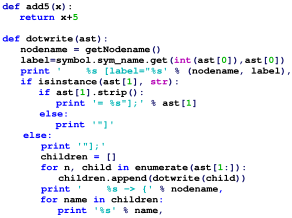This article needs additional citations for verification. (August 2013) |

In computer science, the syntax of a computer language is the rules that define the combinations of symbols that are considered to be correctly structured statements or expressions in that language. This applies both to programming languages, where the document represents source code, and to markup languages, where the document represents data.
The syntax of a language defines its surface form.[1] Text-based computer languages are based on sequences of characters, while visual programming languages are based on the spatial layout and connections between symbols (which may be textual or graphical). Documents that are syntactically invalid are said to have a syntax error. When designing the syntax of a language, a designer might start by writing down examples of both legal and illegal strings, before trying to figure out the general rules from these examples.[2]
Syntax therefore refers to the form of the code, and is contrasted with semantics – the meaning. In processing computer languages, semantic processing generally comes after syntactic processing; however, in some cases, semantic processing is necessary for complete syntactic analysis, and these are done together or concurrently. In a compiler, the syntactic analysis comprises the frontend, while the semantic analysis comprises the backend (and middle end, if this phase is distinguished).
- ^ Friedman, Daniel P.; Mitchell Wand; Christopher T. Haynes (1992). Essentials of Programming Languages (1st ed.). The MIT Press. ISBN 0-262-06145-7.
- ^ Smith, Dennis (1999). Designing Maintainable Software. Springer Science & Business Media.